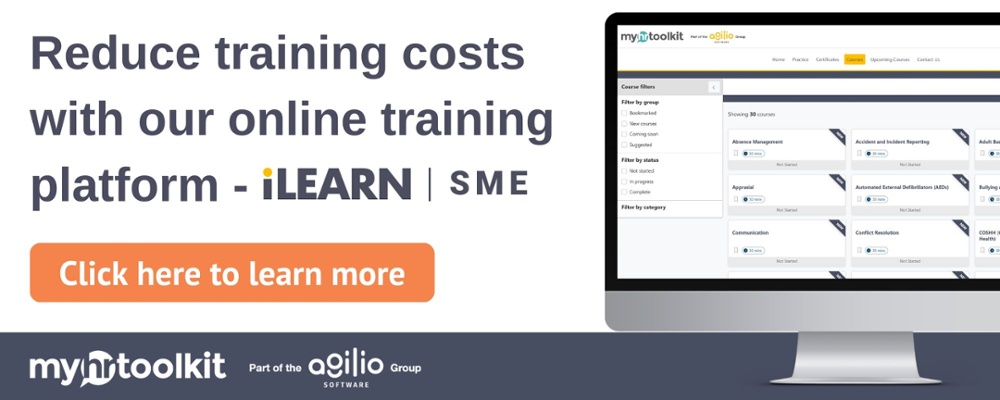Why should employers be upskilling employees and how can you do this successfully for your organisation? HR consultant Kate Marchant of Running HR Ltd shares her 5 top tips on what to consider when upskilling employees.
What is upskilling?

Upskilling can be described as the way in which we obtain new and relevant competencies in today’s world that prepare us for the future world. Upskilling can cover many skills and competencies, although the most desired ones probably exist around all things digital, as many employers are looking to develop their capabilities in this area. And often this starts with their employees…
How to upskill your employees
If employers want to be ahead of the game, they need to understand where their employees are at and where they need to be. To understand the gap between where they are now and where they need them to be, an employer needs to have a vision. Once a clear vision is established, this needs to be communicated to the employees so they are clear on the endgame and why the upskilling is required. It will also give them an early indication of their own personal skill gap.
Learn more: Business training needs analysis guide
Furthermore, employers need to be cognisant of the fact that upskilling is not a one-off event: technology is evolving at a rapid rate and they need to have a strategy and plan as to how they manage this and keep abreast of new developments.
The benefits of upskilling employees

There is payback from upskilling your employees, as it can have the following benefits:
It can help with employee retention
Employees who are given the opportunity to develop and better their competency level are often more likely to stay with that employer, as they can see that investment is being made in them as they acquire new skills.
It can increase efficiency and productivity
Improving digital skills often brings more efficient ways of working, as many manual processes become semi-automated or totally automated. This will, in turn, free up the employee’s time to focus on other areas, giving opportunities for them to add value by being more proactive in some of the activities associated with their role.
It can help with employee engagement
Similar to helping with employee retention, this is a real chance to make employees feel part of the overall vision and for them to understand the part they play in developing the capabilities of the business. This feeling of the ‘one team’ in it together approach can really help drive engagement levels and provide a sense of belonging and achievement to employees.
What to consider when upskilling employees

So, with this backdrop, what are the most important things an employer needs to consider when upskilling or indeed totally reskilling their employees?
1. Learning plans
Learning is a very individual activity and a one size fits all is an unwise approach. Individual plans recognise individual gaps and the rate at which different people learn and develop. Learning plans require joint input from both manager and employee, with the employee being accountable and owning it.
2. Reflection
Given the recent pandemic, it is worth reflecting on want has worked well from a remote learning perspective – again, ask employees about what has worked well for them. Online webinars can be a great way of learning, but they are not the only way to learn. There is a rich tapestry of products that exist to give a varied and effective learning experience, together with some more traditional methods.
3. Accessibility
To enable learning, it should be as accessible from anywhere at any time and on any device. This allows ‘upskillees’ to have maximum flexibility and control over their learning. There are many LMS apps available that can be accessed via mobile phones.
4. Communication
This is key. Employers need to communicate their vision to their employees – what’s the end game, what does success look like? It helps to be clear on what the perceived gap is, how they intend to bridge it, and the ways in which the upskilling will be handled. This gives employees an idea around what to expect and how they will achieve and bridge their own gaps.
For businesses to get some buy in, it can often be highly beneficial to get the employees’ input on vision, strategy, and ways to achieve upskilling. After all, they are the ones at the front end and will have some very valuable experiences and ideas to bring to the table.
5. Support
With an emphasis on upskilling, many employees could feel overwhelmed and daunted at what they are being asked to do – especially if they feel they are being asked to acquire skills beyond their reach. This can often be the case where they are being asked to upskill in areas outside of their comfort zone, especially if they are being asked to upskill around digitalisation.
This is where the individual plans come into play, as they will help managers and employees plan the learning at a rate that is right for the employee and allow for the employee to raise any concerns they may have over what they are being asked to do and any issues they may have around confidence.
Futureproofing your business

Ultimately, the case for upskilling is compelling and is a great way to future proof any business; however, employers need to bring their employees along on the journey and not bombard them with learning. Involve them in the early stages of devising your strategy and vision and employers will reap the rewards of a more engaged, skilled, and productive workforce.
Track employee upskilling with software
With training management software, it's easier to track and manage training efforts across the organisation, from organised company-wide training courses to employees' personal training progress. Software can help you create a useful overview of your training strategy and check up on when training has been completed or needs to be renewed.
Learn more about how training management software can help your business with employee training and upskilling.
Read more from the myhrtoolkit blog
The dos and don’ts of training employees remotely
The benefits of training employees: profit, productivity, people

Written by Kate Marchant
Kate Marchant is an experienced HR professional and CIPD Associate Member who offers straight talking HR solutions for SMEs with friendly and jargon free advice through her consultancy Running HR Ltd.


 Holiday Planner
Holiday Planner Absence Management
Absence Management Performance Management
Performance Management Staff Management
Staff Management Document Management
Document Management Reporting
Reporting Health and Safety Management
Health and Safety Management Task Management
Task Management Security Centre
Security Centre Self Service
Self Service Mobile
Mobile




